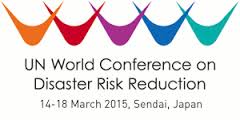Third World Conference on Disaster Risk Reduction (WCDRR 2015)
Just returned from the above UN World Conference on Disaster Risk Reduction - where I represented Duryog Nivaran, and had two speaking slots: as a panellist at the launch of the Global Assessment Report 2015 and at the Ministerial Roundtable on Governing Disaster Risk: overcoming challenges. Also worked closely with the Women's Major Group, coordinated by WEDO. Interesting as UN conferences go, but significant, since its the first of three that are aiming to frame the post-2015 world development agenda - what the world is going to do about disasters, sustainable development and climate. Many interesting thoughts to share... but for now, here is my intervention at the Ministerial Round Table chaired by Ms Maria del Pilar Cornejo, Minister Secretary for Risk Management, Ecuador.
| at the roundtable with the African Union President on my left and the City of Istanbul on my right. Photo by Ramona Miranda |
Since our inception in 1995, we have been working directly with people affected by disasters and organisations that represent them, so we welcome the macro level policy and institutional reforms that have been put into place during the period of the HFA., and the commitment to multistakeholder participation that has been evident in the statements of the delegates to this round table. A little disappointed that there are no South Asian member states represented here.
We would like to reiterate that the way forward is definitely to strengthen local governance processes. In addition to the more dramatic disaster events, there are the extensive risk factors – the droughts, the floods, the landslides, which are highly localised, but which seriously affect the lives of poor women, men and children, and these are trending upwards. Identifying and managing these risks is best done at a local level, but in many South Asian countries, local government institutions often don’t have the capacity, the confidence or the power to do this.
In this context Duryog Nivaran would like to urge member states to:
-INVEST in enabling local government to assess the potential for disaster loss and damage at local level. These assessments need to be integrated across sectors, and equally important, they must become an integral component of local development plans. There will be two gains from this: one is the gain to the local authorities but the other is that the aggregation of this information could improve the quality of national level data sets
- ENCOURAGE local governments to dialogue with their constituencies. Local community organisations can sometimes be captured by the more powerful sections of the communities, so it’s important for local government to talk to the more marginalised members of the communities and to women. There is a lot of evidence to show that women have a good understanding of disaster risk, and capacity to mitigate this risk and that it is important to include them in all DRR activity.
- ENCOURAGE local governments to dialogue with their constituencies. Local community organisations can sometimes be captured by the more powerful sections of the communities, so it’s important for local government to talk to the more marginalised members of the communities and to women. There is a lot of evidence to show that women have a good understanding of disaster risk, and capacity to mitigate this risk and that it is important to include them in all DRR activity.
- PROVIDE RESOURCES for local governments and other data collection agencies to collect and analyse data in a disaggregated manner
-FINALLY, and this is really important, ensure that national and global political considerations do not undermine/override the efforts of local governments to deal with local risks. South Asia is one of the fastest growing economic regions in the world – and we need to mediate our growth with a clear understanding of the risks at the local level.


.jpg)
Comments
Post a Comment